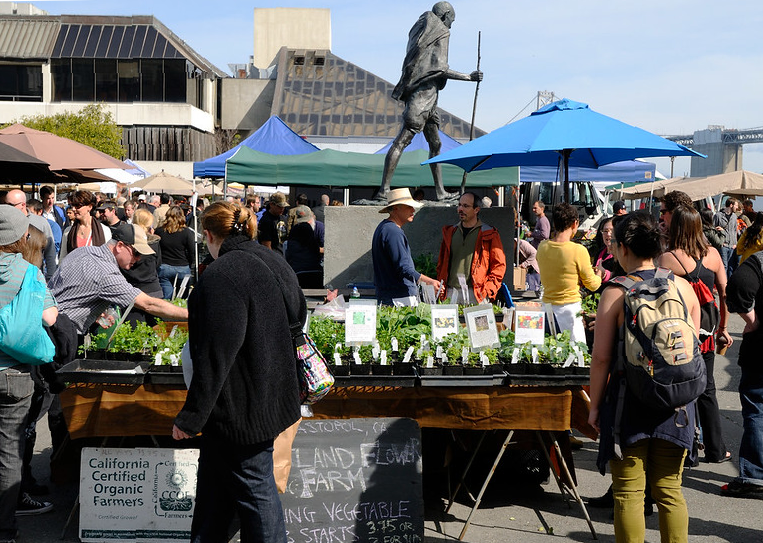
Let’s not forget what we learned during 2020 about the fragility of our food supply chains: the prevailing, globalized model is as fragile as a spider web. It can shatter into dangling threads in times of crisis, such as a pandemic or other natural disaster. Remember the long lines at food banks, while farmers had to scramble to find new markets for their surplus food?
What is food system resilience? Generally, it means shorter supply chains, more direct from “farm to fork;” climate-smart agriculture; robust markets for healthy, minimally processed and humanely produced food; and respect for worker well-being to build community and economic well-being.
Those who are working for a more resilient food system draw inspiration from the farm-to-fork pioneers who challenged the 20th century model of highly industrialized agriculture. And they build on the work of those who took us from the early romance of farmers markets to, scale: for example, The Common Market, a non-profit that runs food hubs which aggregate from local farmers to supply the greater regional scale of food service institutions like school districts.
The City of Los Angeles was a trailblazer in this area. Ten years ago, through an executive order signed by Mayor Villaraigosa and a companion council motion, Los Angeles became the first city in the United States to adopt a policy and program framework emphasizing accountability and transparency in purchasing at its large food service institutions. The initiative, the Good Food Purchasing Program, includes clear evaluation metrics that direct the city’s food dollars to support local economies, environmental sustainability, humane treatment of animals, fair treatment of workers and healthy nutrition. Developed over the course of an intensive two-year, multi-sector stakeholder process, the Good Food Purchasing Program garnered broad support.
Shortly after Villaraigosa’s executive order, the Los Angeles Unified School District followed suit with a board motion. It has since become a beacon in the field, redirecting millions of purchasing dollars into the local food economy, improving nutrition scores, inspiring fair labor practices in the food supply chain, and supporting the development of sustainably sourced products – all within the bounds of the district’s existing budget.
In the decade since its launch, the Good Food Purchasing Program has grown into a national project that any city can enroll in. Twenty-four municipalities around the United States, including Chicago, Denver, New York, Oakland, San Diego and San Francisco and over 60 public food service institutions (mostly school districts) now participate. The Center for Good Food Purchasing, which owns and manages the program, is analyzing a total of over $1.1 billion in purchasing information from these institutions.
In addition to adopting procurement policies, some U.S. mayor’s offices have created food policy positions. The executive branches of Austin, Baltimore, Chicago, Washington DC, Honolulu and New York have created Food Policy Offices. Boston Mayor Michelle Wu, who, as a city councilmember advanced a motion to adopt the Good Food Purchasing Program, has established an Office of Food Justice.
As Olivier De Schutter, United Nations Special Rapporteur on the Right to Food from 2008-2014, observed: “Governments have few sources of leverage over increasingly globalized food systems – but public procurement is one of them. When sourcing food for schools, hospitals and public administrations, governments have a rare opportunity to support more nutritious diets and more sustainable food systems in one fell swoop.”
Indeed, there is much more to this wave of enrollment than expansion of an innovative program that started in LA. It is now part of an international movement of local governments using their purchasing power to build sustainable, resilient food systems.
The Milan Urban Food Policy Pact was launched in 2015 to “reorient school feeding programmes and other institutional food service to provide food that is healthy, local and regionally sourced, seasonal and sustainably produced.” Over 250 global cities have signed on to the Milan Pact. Recently, the Pact recognized New York City with an award for its Good Food Purchasing Framework.
In 2019, the C40, a network of over 100 global cities focused on addressing the climate crisis, created the Good Food Cities Declaration, acknowledging that food is among the largest drivers of global environmental change. The declaration’s signatories pledge to, among other things, “align our food procurement to the Planetary Health Diet, ideally sourced from organic agriculture.” The EAT-Lancet Commission, the intergovernmental scientific group responsible for creating the Planetary Health Diet, has declared that “food is the single strongest lever to optimize human health and environmental sustainability.”
In the United States, the federal government may soon follow suit: President Biden’s federal sustainability plan commits to consider including food purchasing in its goal of reducing emissions. Municipal leadership has often forged the path for national policy.
What’s next? Goals for the next decade include “transforming financial flows, governance structures and food systems from the ground up,” according to the International Panel of Experts on Sustainable Food Systems. In this way, we can build food systems that are healthier, more sustainable and more resilient in an increasingly uncertain world. It’s a journey of a thousand steps – and cities can lead the way.
Paula Daniels is co-founder of the Center for Good Food Purchasing and was Senior Advisor on Food Policy to Mayor Villaraigosa of Los Angeles.






